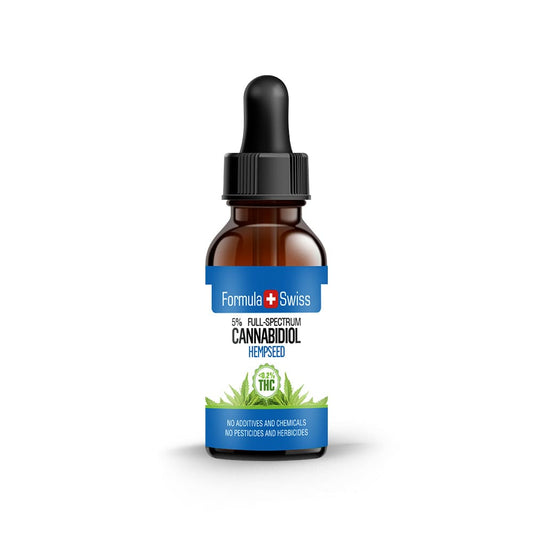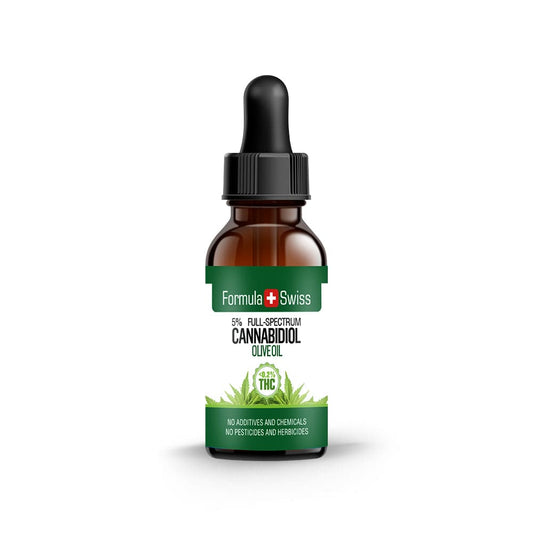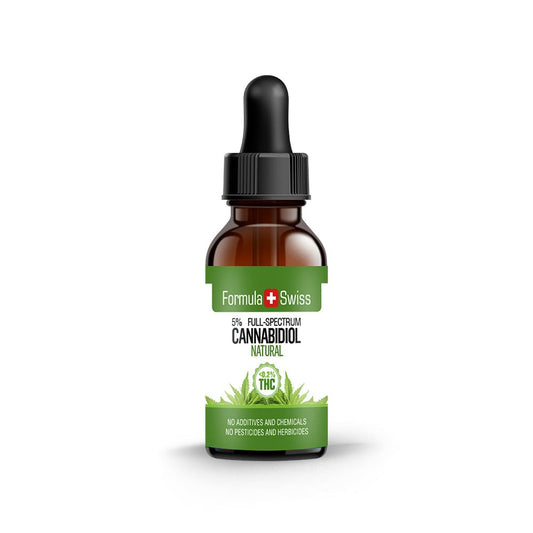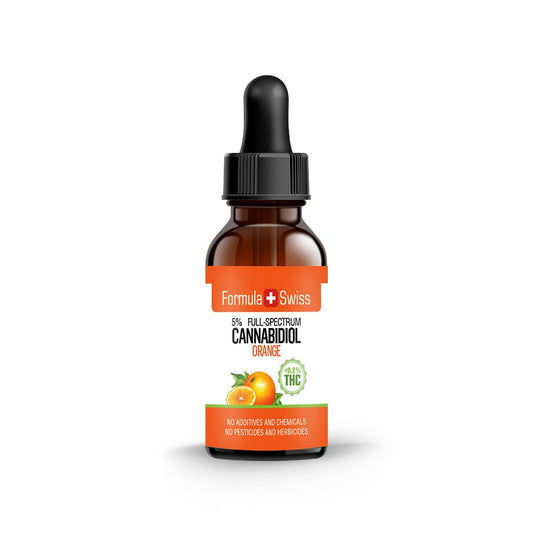Most people familiar with cannabis can name THC or CBD—but far fewer have heard of delta-8 THC. Despite being one of the many compounds found in the cannabis plant, delta-8 remains a lesser-known cannabinoid that’s increasingly attracting both interest and debate.
Delta-8 THC, or delta-8 tetrahydrocannabinol, is a naturally occurring cannabinoid found in small amounts in the cannabis plant. It is structurally similar to the more well-known delta-9 THC, but it behaves a bit differently.
With more than ten years of practical experience working with cannabinoid profiles at Formula Swiss, I’ve seen how much the industry’s understanding has evolved.
I remember when delta-8 was rarely mentioned outside of lab discussions, now it regularly comes up in formulation planning and regulatory reviews. Delta-8 is a great example of a compound that was once overlooked but is now gaining momentum in both research and product development.
Prefer watching over reading? This video covers the key points from the article:
Save up to 30% when you order your CBD oil today
Key takeaways
- An introductory look at the differences and similarities between delta-8 and other cannabinoids.
- Insights into how delta-8 THC is synthesised from the cannabis plant.
- A primer on the potential effects and experiences associated with delta-8 THC usage.
- Knowledge of the manufacturing process and quality control considerations for delta-8 THC products.
This article is provided for informational purposes only and does not relate to any of the products available in our webshop. For more information, please see our full disclaimer.
The science behind delta-8 THC
Delta-8 THC is one of the many cannabinoids found in the cannabis plant. It shares much of its chemical structure with delta-9 THC—the compound more commonly linked to cannabis—but the two differ in the position of a key double bond.
In delta-8 THC, the double bond is on the eighth carbon atom; in delta-9, it’s on the ninth. This small structural difference affects how each compound interacts with cannabinoid receptors in the body, which may influence their effects. These distinctions are part of the reason delta-8 is being more closely studied in cannabis research.
What are cannabinoids?
Cannabinoids like delta-8 THC are naturally occurring compounds in the Cannabis sativa plant. A 2018 review published in the International Journal of Molecular Sciences stated that these compounds interact with the body’s endocannabinoid system, which is involved in various biological functions.
While research into this system is ongoing, its receptors are recognised for their involvement in signalling processes throughout the body.
The chemical structure of delta-8 THC
Delta-8 THC shares a similar molecular framework with delta-9 THC, but with a slight variation: the position of a double bond on the carbon chain.

In delta-8, this bond is on the eighth carbon atom, whereas in delta-9, it is on the ninth. Though seemingly minor, this distinction contributes to how each compound behaves during interactions with cannabinoid receptors.
Delta-8 THC and delta-9 THC
While delta-8 THC and delta-9 THC are structurally alike, their subtle chemical difference leads to varying patterns of interaction with receptors in the brain. This may influence their overall effects and how they are perceived.
Delta-8 THC is often reported to produce effects that are less intense than those associated with delta-9 THC, though individual responses can vary.
Order and get up to 30% off your CBD oil
How is delta-8 THC manufactured?
Delta-8 THC occurs naturally in the cannabis plant, but only in very small amounts—typically less than 1%. Because of this low concentration, it’s rarely extracted directly. Instead, most delta-8 THC on the market is produced through a conversion process using CBD extracted from hemp.
The process begins with the isolation of CBD from hemp using standard extraction methods such as CO₂ or ethanol extraction. Once purified, the CBD undergoes a chemical reaction—often using acid catalysts—that rearranges its molecular structure into delta-8 THC. This synthesis must be carried out under carefully controlled laboratory conditions to ensure safety, accuracy, and compliance with regulatory standards.
Due to the nature of the conversion process, strict quality control is essential. The final product should be thoroughly tested by independent laboratories to verify cannabinoid content and to confirm the absence of residual solvents, heavy metals, or other impurities. Responsible manufacturers also provide Certificates of Analysis (COAs) to ensure transparency and product safety.
This approach allows producers to make delta-8 THC from legally sourced hemp, but the reliance on chemical conversion has raised important discussions within regulatory and scientific communities about product safety and legal classification.
Extraction and synthesis of delta-8 THC
The process of producing delta-8 THC typically begins with extracting CBD from hemp. This CBD is then chemically converted into delta-8 THC through a controlled reaction, allowing for a stable and usable form of the compound.
The choice of extraction method affects the product's quality and safety. Methods like CO2 extraction or solvent-based ones are used based on what's needed and what's available.

Quality control in delta-8 THC production
Maintaining high standards is a priority in the production of delta-8 THC. Each stage of the process is carefully monitored to help ensure that the final product meets strict cleanliness and composition criteria. Independent laboratory testing is conducted to verify the levels and presence of delta-8 THC and to check for any unwanted substances.
| Extraction method | Advantages | Disadvantages |
|---|---|---|
| CO2 extraction | Environmentally friendly, precise | High initial cost |
| Solvent-based extraction | Efficient for large batches | Potential for residual chemicals |
| Enzymatic synthesis | High specificity | Limited scalability |
Common delta-8 THC products explained
I’ve examined various delta-8 products, each offering distinct characteristics. From oils to topicals, this insight contributes to a broader understanding of how delta-8 THC is presented in different product types. It also highlights the range of formats available in the market.
Selecting a delta-8 product involves understanding its format and intended method of use. Here’s an overview of some commonly available forms of delta-8 THC:
| Product type | Description | Typical application |
|---|---|---|
| Oils | Highly concentrated delta-8 THC is typically applied in measured drops. | Used where a compact format with defined dosing is preferred. |
| Gummies and edibles | Chewable or food-based formats containing delta-8 THC. | Favoured for steady release formats, often in controlled portions. |
| Vapes | Delivered via vaporisers or e-cigarette devices. | Commonly selected when a rapid onset of effects is desired. |
| Topicals | Applied externally, including creams and balms. | Designed for targeted, surface-level application. |
When selecting a delta-8 THC product, it helps to understand its intended function, delivery method, and format suitability. The choice often depends on practical factors such as portability, usage setting, and duration of intended application.
Each format serves a different preference. Some may prioritise ease of use or quick onset, while others may prefer a gradual profile or topical format. Aligning product choice with individual routines and requirements can improve practicality.

The range of delta-8 THC products supports varied uses across personal routines and preferences. As interest continues, so does the development of diverse product options suited to a broad user base.
Order CBD oil now and save as much as 30%
The experience of using delta-8 THC
Delta-8 THC is often described as producing milder effects than delta-9 THC—some users report a clearer headspace or a lighter overall sensation. For this reason, it’s sometimes preferred by those looking for a more moderate experience.
In my own work with cannabinoid profiling, I’ve spoken to many people who find delta-8 offers a gentler option, especially if they’re trying to avoid the intensity often linked to high-THC products.
That said, effects can vary. Tolerance, dosage, and method of use all influence how the compound is felt. As with any cannabinoid, it's important to start low, go slow, and pay attention to how your body responds.
What to expect when using delta-8 THC
Delta-8 THC is often described as offering a more measured profile. Some individuals report subtle shifts in perception or mood. These outcomes may be influenced by factors such as delivery method, dosage, and personal sensitivity.
Safety and responsibility in usage
Delta-8 THC interacts with the body’s endocannabinoid system, a network involved in internal signalling processes. Those working with delta-8 products are advised to start with minimal quantities and observe their response. Responsible handling includes monitoring individual reactions and avoiding excessive use.
Using delta-8 THC should be approached thoughtfully. It is important to remain attentive to context, setting, and personal response, keeping in mind any relevant safety considerations related to cannabinoid exposure.
The Endocannabinoid System (ECS)
Comparing delta-8 THC to other cannabinoids
Examining the properties of various cannabinoids can offer insight into their distinct characteristics. Delta-8 THC and CBD are two of the more widely recognised compounds, each with unique profiles and applications.

Delta-8 THC is noted for its mild psychoactive effects, whereas CBD is non-psychoactive. This distinction often influences how individuals choose to work with these substances depending on their preferences and requirements.
| Cannabinoid | Psychoactive | Commonly reported characteristics |
|---|---|---|
| Delta-8 THC | Yes, mild | Described as producing a gentler response compared to delta-9 THC |
| CBD | No | Non-psychoactive; often selected for its non-intoxicating profile |
| CBN | Yes, very mild | Typically noted for its presence in aged cannabis extracts |
| CBG | No | Under investigation for its potential in non-psychoactive applications |
CBD stands out due to its non-psychoactive nature, and it continues to be a focus of ongoing research. Cannabinoids such as CBN and CBG are also receiving increased attention as scientific interest grows in the broader profile of compounds found in the cannabis plant.
Comparing Delta-8 THC to CBD and other cannabinoids can help highlight the range of options currently available. Each compound offers a distinct set of traits, and selection often depends on individual goals and preferences in product formulation or application.
Which cannabinoids produce a psychoactive effect?
The chemistry of delta-8 THC
In examining the chemistry of delta-8 THC, it is important to clarify misconceptions and improve understanding. This is not only about the molecular structure but also about addressing misinformation that influences public perception.
Numerous inaccuracies have circulated regarding delta-8 THC, which can affect how it is viewed and handled. Linking chemical knowledge with verifiable information supports more informed public discourse.

Addressing misinformation around Delta-8 THC
Misinformation often results from unclear communication and myths passed along through media or informal sources. One common misunderstanding is that delta-8 THC lacks psychoactive properties. It does exhibit mild psychoactivity. Accurate discussion about delta-8 THC should be based on confirmed chemical data and official sources.
Important safety measures and warnings
In the context of delta-8 THC, safety requires attention to several key practices:
- Product labelling should be precise, with clear information on content and usage guidelines.
- Products should be obtained from reputable sources that provide full transparency regarding composition and production standards.
- Educational initiatives can support better public understanding of both the limitations and appropriate handling of delta-8 THC materials.
These steps are relevant for both manufacturers and end users, contributing to improved awareness and safer practices.
What’s next for delta-8 THC?
Interest in delta-8 THC continues to grow, particularly within scientific and product development circles. Research is focusing on its structure, production methods, and how it fits into the wider cannabinoid profile of the cannabis plant.
As more studies are published and public awareness improves, the understanding of delta-8 THC is likely to become more defined. These developments may influence how it's handled in both research settings and product formulation, encouraging more consistent and informed approaches across the industry.
Personal perspective
After spending years working with cannabinoid profiles, I’ve seen how quickly things can change. Delta-8 THC is a good example. It wasn’t on many people’s radar for a long time, but now it’s part of ongoing conversations—both in research and product development.
What stands out to me is how often people misunderstand it. There’s a lot of noise online, and it’s not always clear what delta-8 actually is or how it’s made. I’ve had many conversations where people are surprised to learn it’s usually converted from CBD and not just extracted from the plant in large amounts.
That’s why I think it’s important to keep things honest and straightforward. When you work closely with cannabinoids every day, you start to see how much clarity matters, especially with compounds like delta-8 that come with so many questions.
Don’t miss out—save up to 30% when you purchase CBD oil today
Frequently asked questions
What exactly is delta-8 THC?
Delta-8 THC is a type of cannabinoid found in the cannabis plant. It is structurally similar to delta-9 THC but contains a slight molecular variation. This distinction influences how it interacts with biological systems.
How is delta-8 THC manufactured?
Delta-8 THC is typically produced through a chemical conversion process involving cannabinoids extracted from the cannabis plant. This procedure requires careful attention to detail and adherence to high-quality standards to ensure the integrity of the final product.
What should I expect when using delta-8 THC?
Delta-8 THC is often described as having a more moderate psychoactive profile compared to delta-9 THC. Reported effects may include shifts in perception or mood, though individual responses can vary considerably.
How does delta-8 THC compare to CBD?
Delta-8 THC is mildly psychoactive, while CBD is not. CBD is commonly selected for non-intoxicating use. Both cannabinoids interact with the endocannabinoid system in different ways and are studied for distinct applications.
What are some safety measures and warnings related to delta-8 THC?
It is advisable to source delta-8 THC products from reputable suppliers that provide detailed product information and lab verification. Use of such materials should be approached cautiously, especially when operating vehicles or machinery. Factors such as personal tolerance should be taken into account.
What does the future look like for delta-8 THC?
The future of delta-8 THC will likely be influenced by continued scientific research and advancements in understanding. As evidence-based studies progress, they will play a key role in guiding how delta-8 THC is considered in product development and industry practices.






